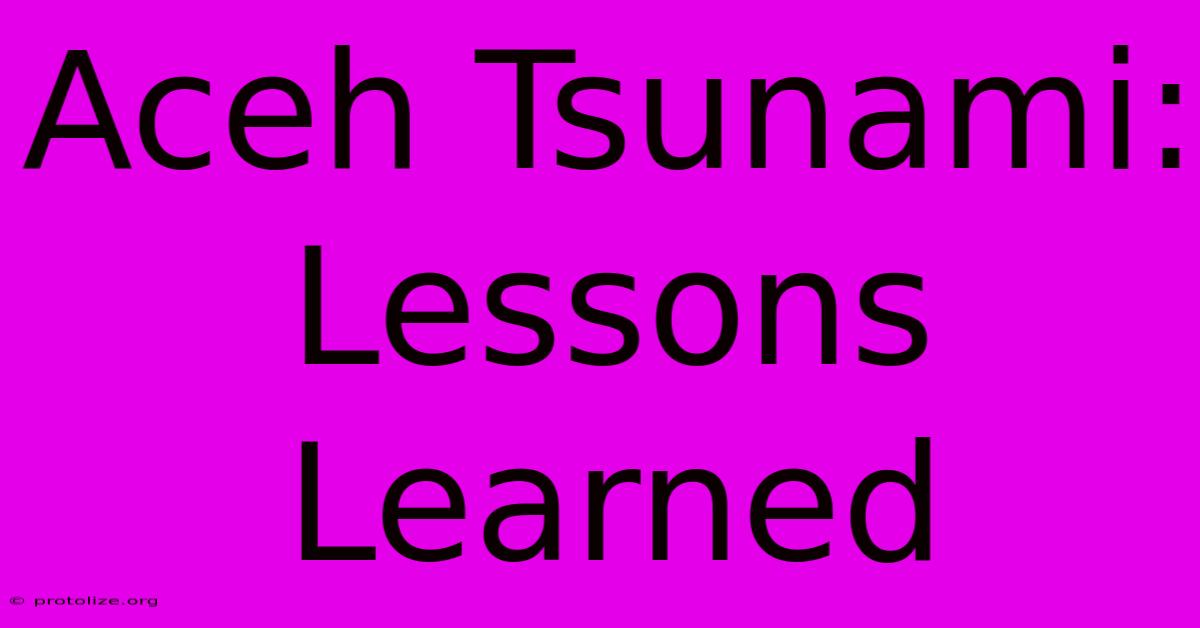Aceh Tsunami: Lessons Learned

Discover more detailed and exciting information on our website. Click the link below to start your adventure: Visit Best Website mr.cleine.com. Don't miss out!
Table of Contents
Aceh Tsunami: Lessons Learned - A Decade of Resilience and Reconstruction
The 2004 Indian Ocean tsunami, which devastated Aceh, Indonesia, remains one of history's most catastrophic natural disasters. The sheer scale of destruction – over 170,000 lives lost and widespread devastation – underscored the urgent need for improved disaster preparedness, response, and recovery strategies. More than two decades later, the lessons learned from the Aceh tsunami continue to shape global disaster management practices.
Understanding the Devastating Impact
The tsunami's impact on Aceh was profound and multifaceted. The immediate aftermath saw a chaotic scramble for survival, hampered by a lack of coordinated emergency response and communication breakdowns. The sheer scale of the destruction overwhelmed local and national resources, highlighting critical deficiencies in infrastructure, early warning systems, and community preparedness. Beyond the immediate loss of life, the tsunami triggered a cascade of secondary impacts:
- Physical Destruction: Widespread infrastructure damage, including homes, hospitals, schools, and vital lifelines like roads and communication networks.
- Economic Devastation: The destruction of livelihoods, businesses, and agricultural lands crippled the Acehnese economy.
- Social Trauma: The immense loss of life and the psychological trauma inflicted on survivors created lasting social and mental health challenges.
- Environmental Damage: Saltwater intrusion into freshwater sources and the disruption of coastal ecosystems had long-term environmental consequences.
Key Lessons Learned from the Aceh Tsunami
The Aceh tsunami served as a brutal but invaluable teacher, highlighting critical areas for improvement in disaster management:
1. The Importance of Early Warning Systems
The lack of a reliable and effective early warning system contributed significantly to the high death toll. The Aceh experience underscored the need for robust, multi-layered warning systems, including community-based warning networks and improved communication infrastructure. Real-time monitoring, accurate predictions, and effective dissemination of warnings are crucial for minimizing casualties.
2. Community Participation and Preparedness
Successful disaster management hinges on community participation. The Aceh tragedy demonstrated the critical role of community-based preparedness initiatives, including education programs, evacuation drills, and the development of local response plans. Empowering communities to take ownership of their safety is paramount.
3. Strengthening Infrastructure and Building Codes
The tsunami exposed vulnerabilities in Aceh's infrastructure, particularly in coastal areas. Investing in resilient infrastructure, including tsunami-resistant buildings and improved drainage systems, is essential for mitigating future damage. Stricter building codes and enforcement are also crucial.
4. Coordinated Disaster Response and International Cooperation
The initial response to the tsunami was hampered by a lack of coordination between various agencies and organizations. The Aceh experience highlighted the need for improved coordination mechanisms, both domestically and internationally. Effective collaboration between government agencies, NGOs, and international relief organizations is crucial for efficient and effective disaster response.
5. Post-Disaster Recovery and Reconstruction
The long-term recovery and reconstruction process in Aceh provided valuable insights into the challenges of rebuilding communities after a major disaster. This involved not only physical reconstruction but also addressing the social, economic, and psychological needs of survivors. Sustainable and participatory reconstruction processes are critical for long-term resilience.
6. The Role of Education and Awareness
Education plays a critical role in reducing vulnerability to future tsunamis. Comprehensive education programs focusing on tsunami awareness, preparedness, and risk reduction strategies are vital for building community resilience.
Aceh Today: A Legacy of Resilience
Despite the unimaginable devastation, Aceh has demonstrated remarkable resilience. The province has invested heavily in early warning systems, disaster preparedness programs, and infrastructure improvements. The lessons learned from the 2004 tsunami have not only benefited Aceh but have also shaped global disaster management strategies, emphasizing the importance of preparedness, community involvement, and international cooperation in mitigating the impact of future disasters. The story of Aceh’s recovery is a testament to the human spirit’s ability to overcome adversity and build back stronger. The ongoing efforts to improve disaster preparedness and resilience continue to serve as an important case study for disaster risk reduction worldwide.

Thank you for visiting our website wich cover about Aceh Tsunami: Lessons Learned. We hope the information provided has been useful to you. Feel free to contact us if you have any questions or need further assistance. See you next time and dont miss to bookmark.
Featured Posts
-
Michail Antonio Update West Ham Fc
Dec 09, 2024
-
Capital Jingle Bell Ball 2024 Fashion
Dec 09, 2024
-
Arsenal Drops Points Fulham 1 1 Stats
Dec 09, 2024
-
Bucs Raiders Inactive Report Irving Plays
Dec 09, 2024
-
Robbie Worried Di Caprio Slap Arrest
Dec 09, 2024
